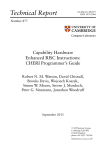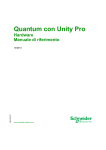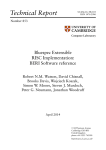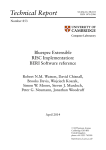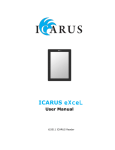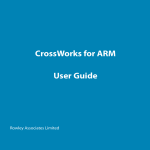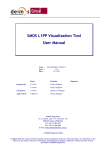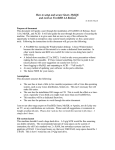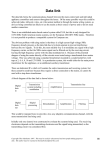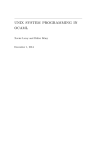Download paper - Information Security Research Group
Transcript
Technical Report
UCAM-CL-TR-851
ISSN 1476-2986
Number 851
Computer Laboratory
Capability Hardware
Enhanced RISC Instructions:
CHERI User’s guide
Robert N.M. Watson, David Chisnall,
Brooks Davis, Wojciech Koszek,
Simon W. Moore, Steven J. Murdoch,
Peter G. Neumann, Jonathan Woodruff
April 2014
15 JJ Thomson Avenue
Cambridge CB3 0FD
United Kingdom
phone +44 1223 763500
http://www.cl.cam.ac.uk/
c 2014 Robert N.M. Watson, David Chisnall, Brooks Davis,
Wojciech Koszek, Simon W. Moore, Steven J. Murdoch,
Peter G. Neumann, Jonathan Woodruff
SRI International is acknowledged as an additional copyright
holder
Technical reports published by the University of Cambridge
Computer Laboratory are freely available via the Internet:
http://www.cl.cam.ac.uk/techreports/
ISSN 1476-2986
Abstract
The CHERI User’s Guide documents the software environment for the Capability Hardware
Enhanced RISC Instructions (CHERI) prototype developed by SRI International and the University of Cambridge. The User’s Guide is targeted at hardware and software developers working with capability-enhanced software. It describes the CheriBSD operating system, a version
of the FreeBSD operating system that has been adapted to support userspace capability systems
via the CHERI ISA, and the CHERI Clang/LLVM compiler suite. It also describes the earlier
Deimos demonstration microkernel.
3
Acknowledgments
The authors of this report thank other current and past members of the CTSRD team, and our
past and current research collaborators at SRI and Cambridge:
Ross J. Anderson
Jonathan Anderson
Khilan Gudka
Jong Hun Han
Asif Khan
Myron King
Anil Madhavapeddy Ilias Marinos
Andrew Moore
Will Morland
Robert Norton
Philip Paeps
John Rushby
Hassen Saidi
Stacey Son
Richard Uhler
Gregory Chadwick
Alex Horsman
Ben Laurie
A. Theodore Markettos
Alan Mujumdar
Michael Roe
Hans Petter Selasky
Philip Withnall
Nirav Dave
Alexandre Joannou
Patrick Lincoln
Ed Maste
Prashanth Mundkur
Colin Rothwell
Muhammad Shahbaz
Bjoern Zeeb
The CHERI team wishes thank its external oversight group for significant support and contributions:
Lee Badger
Simon Cooper
Rance DeLong Jeremy Epstein
Virgil Gligor
Li Gong
Mike Gordon
Steven Hand
Andrew Herbert
Warren A. Hunt Jr. Doug Maughan Greg Morrisett
Brian Randell
Kenneth F. Shotting Joe Stoy
Tom Van Vleck
Samuel M. Weber
Finally, we are grateful to Howie Shrobe, MIT professor and past DARPA CRASH program
manager, who has offered both technical insight and support throughout this work. We are also
grateful to Robert Laddaga, who has succeeded Howie in overseeing the CRASH program.
4
Contents
1
2
3
Introduction
1.1 Background . . . .
1.2 Getting BERI . . .
1.3 Licensing . . . . .
1.4 Version History . .
1.5 Document Structure
.
.
.
.
.
.
.
.
.
.
.
.
.
.
.
.
.
.
.
.
.
.
.
.
.
.
.
.
.
.
.
.
.
.
.
.
.
.
.
.
.
.
.
.
.
.
.
.
.
.
.
.
.
.
.
.
.
.
.
.
.
.
.
.
.
.
.
.
.
.
.
.
.
.
.
.
.
.
.
.
.
.
.
.
.
.
.
.
.
.
.
.
.
.
.
CheriBSD
2.1 CheriBSD Modifications . . . . . . . . . . . . . . . .
2.2 Obtaining FreeBSD/BERI and CheriBSD Source Code
2.3 About FreeBSD/BERI and CheriBSD . . . . . . . . .
2.4 Building CheriBSD . . . . . . . . . . . . . . . . . . .
.
.
.
.
.
.
.
.
.
.
.
.
.
.
.
.
.
.
.
.
.
.
.
.
.
.
.
CHERI Clang/LLVM
3.1 Cross-Compiling for CHERI . . . . . . . . . . . . . . . . .
3.2 Building the Assembler . . . . . . . . . . . . . . . . . . . .
3.3 Building the Compiler . . . . . . . . . . . . . . . . . . . .
3.4 Building a Complete SDK . . . . . . . . . . . . . . . . . .
3.5 Using Clang . . . . . . . . . . . . . . . . . . . . . . . . . .
3.6 Disassembling CHERI Binaries . . . . . . . . . . . . . . .
3.7 Capability Extensions to C . . . . . . . . . . . . . . . . . .
3.7.1 Querying Reserved Capability Registers . . . . . . .
3.7.2 Other Builtins . . . . . . . . . . . . . . . . . . . . .
3.7.3 Inline Assembly . . . . . . . . . . . . . . . . . . .
3.7.4 Const and Capabilities . . . . . . . . . . . . . . . .
3.7.5 Output-Only Capabilities . . . . . . . . . . . . . . .
3.7.6 Capability Implicit Range Checking . . . . . . . . .
3.7.7 Opaque Types . . . . . . . . . . . . . . . . . . . . .
3.7.8 Object-Capability Invoke Calling Convention . . . .
3.7.9 Stack Spills and Safety . . . . . . . . . . . . . . . .
3.8 Assembly Extensions . . . . . . . . . . . . . . . . . . . . .
3.8.1 Capability Move . . . . . . . . . . . . . . . . . . .
3.8.2 Capability-Relative Floating-Point Loads and Stores
5
.
.
.
.
.
.
.
.
.
.
.
.
.
.
.
.
.
.
.
.
.
.
.
.
.
.
.
.
.
.
.
.
.
.
.
.
.
.
.
.
.
.
.
.
.
.
.
.
.
.
.
.
.
.
.
.
.
.
.
.
.
.
.
.
.
.
.
.
.
.
.
.
.
.
.
.
.
.
.
.
.
.
.
.
.
.
.
.
.
.
.
.
.
.
.
.
.
.
.
.
.
.
.
.
.
.
.
.
.
.
.
.
.
.
.
.
.
.
.
.
.
.
.
.
.
.
.
.
.
.
.
.
.
.
.
.
.
.
.
.
.
.
.
.
.
.
.
.
.
.
.
.
.
.
.
.
.
.
.
.
.
.
.
.
.
.
.
.
.
.
.
.
.
.
.
.
.
.
.
.
.
.
.
.
.
.
.
.
.
.
.
.
.
.
.
.
.
.
.
.
.
.
.
.
.
.
.
.
.
.
.
.
.
.
.
.
.
.
.
.
.
.
.
.
.
.
.
.
.
.
.
.
.
.
.
.
.
.
.
.
.
.
.
.
.
.
.
.
.
.
.
.
.
.
.
.
.
7
7
8
8
8
9
.
.
.
.
10
10
11
11
11
.
.
.
.
.
.
.
.
.
.
.
.
.
.
.
.
.
.
.
14
14
14
14
15
16
16
17
18
18
18
18
19
19
19
20
20
21
21
21
4
The Deimos Demonstration Operating System
4.1 Demonstration Narrative . . . . . . . . . .
4.2 Deimos Design and Implementation . . . .
4.2.1 Supervisor . . . . . . . . . . . . .
4.2.2 Memory . . . . . . . . . . . . . . .
4.2.3 CHERI-Aware ABI . . . . . . . . .
4.3 Building Deimos . . . . . . . . . . . . . .
4.4 Conclusion . . . . . . . . . . . . . . . . .
6
.
.
.
.
.
.
.
.
.
.
.
.
.
.
.
.
.
.
.
.
.
.
.
.
.
.
.
.
.
.
.
.
.
.
.
.
.
.
.
.
.
.
.
.
.
.
.
.
.
.
.
.
.
.
.
.
.
.
.
.
.
.
.
.
.
.
.
.
.
.
.
.
.
.
.
.
.
.
.
.
.
.
.
.
.
.
.
.
.
.
.
.
.
.
.
.
.
.
.
.
.
.
.
.
.
.
.
.
.
.
.
.
.
.
.
.
.
.
.
.
.
.
.
.
.
.
.
.
.
.
.
.
.
22
22
23
23
25
25
25
26
Chapter 1
Introduction
This is the User’s Guide for the Capability Hardware Enhanced RISC Instructions (CHERI)
prototype. The User’s Guide complements the CHERI Instruction-Set Architecture (which
specifies the CHERI ISA), the BERI Hardware Reference (which describes the hardware prototype), and the BERI Software Reference (which describes the BERI software development
environment).
The User’s Guide describes the CheriBSD operating-system prototype, a version of the
Clang/LLVM/gas toolchain used with CHERI, and the Deimos demonstration microkernel.
The Guide is intended to address the needs of hardware and software developers who are
prototyping new hardware features or bringing up operating systems, language runtimes, and
compilers on CHERI, rather than literal end users. Future iterations will continue to flesh out
operational aspects of the CHERI processor.
1.1
Background
Capability Hardware Enhanced RISC Instructions (CHERI), developed by SRI International
and the University of Cambridge, are security extensions for the 64-bit MIPS Instruction Set
Architecture (ISA). The CHERI ISA provides direct processor support for fine-grained memory
protection and scalable compartmentalization of (and within) system software and application
software.
Whereas traditional CPU designs impose heavy performance and programmability penalties for employing compartmentalization, CHERI’s ISA features support fast and easy application compartmentalization of C-language systems software. These improvements are made
possible by integrated processor support for continuous memory protection and enforcement
using memory capabilities and the object-capability model. Contemporary software trusted
computing bases (TCBs) such as operating-system kernels and language runtimes are particularly interesting targets, as CHERI will allow us to improve their security and reliability – and,
therefore, the security and reliability of applications built on top of those services.
Detailed information on the CHERI ISA and possible uses may be found in the CHERI
Instruction-Set Architecture, including new coprocessor registers and instructions. The CHERI
prototype is a reference implementation of the CHERI ISA, intended to help validate the approach through a complete system implementation. CHERI is based on the Bluespec Extensible
RISC Implementation (BERI) FPGA soft core, and is implemented as an additional coprocessor. The distinction between BERI and CHERI is evolving; however, our hope is that BERI
7
will be a reusable platform across multiple research projects relating to the hardware-software
interface. We have open sourced both our hardware prototypes and software support for them
in the form of FreeBSD device drivers, extensions to the Clang/LLVM compiler suite, and
CheriBSD, a version of FreeBSD enhanced to utilize the CHERI ISA for fine-grained memory
protection and compartmentalization.
1.2
Getting BERI
We distribute the BERI prototype and software stack as open source via the BERI website:
http://www.beri-cpu.org/
1.3
Licensing
The BERI hardware design, simulated peripherals, and software tools are available under the BERI
Hardware-Software License, a lightly modified version of the Apache Software License that takes into
account hardware requirements.
We have released our extensions to the FreeBSD operating system to support BERI under a BSD
license; initial support for BERI was included in FreeBSD 10.0, but further features will appear in
FreeBSD 10.1. We have also released versions of FreeBSD and Clang/LLVM that support the CHERI
ISA under a BSD license; these are distributed via GitHub.
We welcome contributions to the BERI project; however, we are only able to accept non-trivial
changes when an individual or corporate contribution agreement has been signed. The BERI hardwaresoftware license and contribution agreement may be found at:
http://www.beri-open-systems.org/
1.4
Version History
1.0 An initial version of the CHERI User’s Guide documented the implementation status of the CHERI
prototype, including the CHERI ISA and processor implementation, as well as user information
on how to build, simulate, debug, test, and synthesize the prototype.
1.1 Minor refinements were made to the text and presentation of the document, with incremental updates
to its descriptions of the SRI/Cambridge development and testing environments.
1.2 This version of the CHERI User’s Guide followed an initial demonstration of CHERI synthesized
for the Terasic tPad FPGA platform. The Guide contained significant updates on the usability
of CHERI features, the build process, and debugging features such as CHERI’s debug unit. A
chapter was added on Deimos, a demonstration microkernel for the CHERI architecture.
1.3 The document was restructured into hardware prototype and software reference material. Information on the status of MIPS ISA implementation was updated and expanded, especially with
respect to the MMU. Build dependencies were updated, as was information on the CHERI simulation environment. The distinction between BERI and CHERI was discussed in detail. The
Altera development environment was described in its own chapter. A new chapter was added that
detailed bus and device configuration and use of the Terasic tPad and DE4 boards, including the
Terasic/Cambridge MTL touch screen display. New chapters were added on building and using
8
CheriBSD, as well as a chapter on FreeBSD device drivers on BERI/CHERI. A new chapter was
added on cross-building and using the CHERI-modified Clang/LLVM suite, including C-language
extensions for capabilities.
1.4 This version introduced improved Altera build and Bluespec simulation instructions. A number
of additional C-language extensions that can be mapped into capability protections were introduced. FreeBSD build instructions were updated for changes to the FreeBSD cross-build system.
Information on the CHERI2 prototype was added.
1.5 In this version of the CHERI User’s Guide, several chapters describe the CHERI hardware prototype
have been moved into a separate document, the CHERI Platform Reference Manual, leaving the
User’s Guide focused on software-facing activities.
1.6 This version updated the CHERI User’s Guide for changes in the CheriBSD build including support
for the CFI driver, incorporation of Subversion into the FreeBSD base tree, and non-root cross
builds. It also added information on the quartus pgm command, and made a number of minor
clarifications and corrections throughout the document.
1.7 In this version, information on building and using FreeBSD/BERI was moved to the BERI Software
Reference. A short chapter describing CheriBSD was retained, and updated to reflect a migration
from Perforce to Github. Information on the CHERI Clang/LLVM compiler was updated to
include new C-language extensions. CheriBSD build instructions were extended to support the the
CHERI Clang/LLVM compiler. Information on CheriBSD extensions to FreeBSD was expanded.
1.8 - UCAM-CL-TR-851 This version of the CHERI User’s Guide was made available as a University of Cambridge Technical Report. Information on CheriBSD was updated to reflect enhanced
support for sandboxing, signal handling, and testing. A variety of changes were made to reflect
open sourcing of the BERI/CHERI processors and associated software stacks. New CHERI Clang
built-in functions for clearing capability-pointer tags and querying the capability-program counter
are now documented.
1.5
Document Structure
This document is an introduction and user manual for Version 1 of the Capability Hardware Enhanced
RISC Instructions CPU prototype:
Chapter 2 describes CheriBSD.
Chapter 3 describes CHERI extensions to Clang/LLVM and the C programming language.
Chapter 4 describes Deimos, a prototype operating-system software stack for CHERI. This microkernel,
which runs on CHERI in simulated and synthesized forms, illustrates some of CHERI’s protection and
compatibility properties.
9
Chapter 2
CheriBSD
FreeBSD/BERI is a port of the open-source FreeBSD operating system that extends support for the
Bluespec Extensible RISC implementation (BERI). CheriBSD extends FreeBSD/BERI to implement
memory protection and software compartmentalization features supported by the CHERI ISA. General
crossbuild and use instructions for FreeBSD/BERI may be found in the BERI Software Reference. Procedures for building and using FreeBSD/BERI should entirely apply to CheriBSD, except as documented
in this chapter.
2.1
CheriBSD Modifications
FreeBSD/BERI has been modified in the following ways to support CHERI’s security features:
• Platform boot code has been extended to enable the capability co-processor.
• The per-thread PCB context structure has been extended to hold a saved capability register file, as
well as a per-thread ‘trusted stack’ that tracks object-capability invocations to provide a reliable
return path.
• Kernel context-switching code has been extended to save and restore the capability register file
for userspace.
• The kernel’s handling of user exceptions has been extended to provide additional debugging information when userspace protection faults occur.
• The kernel rejects attempts to perform system calls from user threads whose PCC (programcounter capability) register does not have the CHERI_PERM_SYSCALL user-defined permission
bit, preventing sandboxes from directly invoking system services. They must instead invoke a
system class that is authorized to invoke system calls. We also hope to introduce new system
calls that are safe within sandboxes and are authorized using special user capabilities – e.g., user
capabilities that represent kernel file descriptors directly, avoiding the need for interposition –
similar to the behavior of Capsicum.
• The kernel implements CCall and CReturn fast exception handlers that unseal invoked object
capabilities, push the caller state onto the trusted stack, and restore it on return. If a fault occurs
in the invoked object, control is returned to the caller.
• The kernel delivers capability-coprocessor faults in userspace processes as signals, extending the
signal trap frame to include capability registers. This allows userspace software (and, in particular,
language runtimes) to catch and handle software protection faults.
10
• The kernel is extended to allow processes that implement sandboxing to export class, method,
and object statistics.
• The libprocstat(3) library and procstat(1) command have been extended to inspect
exported sandbox statistics.
• A new library, libcheri(3), has been added to provide a sandbox API, and to implement a set
of system-class objects that can be delegated to sandboxes. Currently, this consists of a singleton
system object that provides the ability to print to stdout, and a file-descriptor class that allows
delegation of individual kernel-provided file descriptors to sandboxes.
• A new library, libc cheri(3), has been added to provide core C-language APIs and services within
sandboxes. This library is able to use the system and file-descriptor classes to provide access to
APIs such as printf().
• A new command-line tool, cheritest, implements test cases for a variety of capability-related
functions including sandboxing; cheritest relies on cheritest-helper.bin to provide
sandboxed code.
• A new command-line tool, cheri tcpdump, implements sandboxed packet sniffing and parsing; cheri tcpdump relies on tcpdump-helper to provide sandboxed code.
• A new library, libz-cheri(3), implements compression routines with fine-grained memory
protection.
2.2
Obtaining FreeBSD/BERI and CheriBSD Source Code
Source code for CheriBSD is maintained on GitHub in the following repository:
https://github.com/CTSRD-CHERI/cheribsd
The CheriBSD development tree is branched from the FreeBSD GitHub repository at:
https://github.com/freebsd/freebsd
Development takes place on the master branch, which will eventually become FreeBSD 11.x. CheriBSD
may be retrieved from GitHub as follows:
$ git clone https://github.com/CTSRD-CHERI/cheribsd
2.3
About FreeBSD/BERI and CheriBSD
CheriBSD contains additions to FreeBSD/BERI to support the CHERI capability coprocessor. Table 2.1
contains a list of directories affected by CHERI-specific behavior. Table 2.2 lists CHERI-specific files
in the common MIPS configuration directory.
2.4
Building CheriBSD
CheriBSD follows the same build instructions as those found in the BERI Software Reference chapter on
building FreeBSD/BERI, substituting source code from the above Git repository, as well as pathnames
and kernel names in build commands.
11
Filename
Description
bin/cheritest/
Command-line utility exercising CHERI and
CheriBSD features, including sandboxing
CTSRD-project demo code
In-sandbox C library/runtime
Library implementing the CHERI sandbox API;
the CHERI system class implementation
Sandboxed components for cheritest
Sandboxed components for cheri tcpdump
CHERI-specific code: coprocessor 2
initialization and context management
ctsrd/
lib/libc cheri/
lib/libcheri/
libexec/cheritest-helper/
libexec/tcpdump-helper/
sys/mips/cheri/
lib/libz-cheri
usr.sbin/tcpdump/cheri tcpdump
lib/libprocstat/
usr.bin/procstat/
Version of libz compiled with CHERI memory
protection
Version of tcpdump able to use CHERI sandboxing
Extensions to this library allow procstat(1) to
monitor libcheri sandboxes
procstat(1) command extended to monitor
libcheri standboxes
Table 2.1: CheriBSD directories
Filename
Description
CHERI DE4 MDROOT
CheriBSD kernel configuration to use a memory root file
system on the Terasic DE4
CheriBSD kernel configuration to use an SD Card root file
system on the Terasic DE4
CheriBSD kernel configuration to use a memory root file
system while in simulation
CheriBSD kernel configuration to use a simulated SD Card
root file system
CHERI DE4 SDROOT
CHERI SIM MDROOT
CHERI SIM SDROOT
Table 2.2: CheriBSD files in src/sys/mips/conf.
12
Portions of the CheriBSD tree rely on our CHERI-aware Clang/LLVM extensions (described in
Chapter 3). You must tell make buildworld where to find the extended Clang/LLVM by adding
this argument to the build command line:
CHERI_CC=/path/to/cheri-unknown-freebsd-clang
Typically, this argument will be a pointer to the Build/bin directory in your CHERI Clang/LLVM
build, or bin in the CHERI SDK.
Some utility and demonstration software is stored in the ctsrd and tools/tools/atsectl
directories. They can be built with the world by adding the following to the make buildworld
command line:
LOCAL_DIRS="ctsrd tools/tools/atsectl" \
LOCAL_LIB_DIRS=ctsrd/lib \
LOCAL_MTREE=ctsrd/ctsrd.mtree
You will similarly need to include the following lines for the make installworld target:
LOCAL_DIRS="ctsrd tools/tools/atsectl" \
LOCAL_MTREE=ctsrd/ctsrd.mtree
Support for the capability coprocessor is an optionally compiled extension enabled using cpu
CPU CHERI in CheriBSD. Ensure that you have replaced a BERI kernel configuration-file name with a
similar CHERI name to ensure that nocpu CPU BERI and cpu CPU CHERI lines have been used.
13
Chapter 3
CHERI Clang/LLVM
This chapter describes CHERI-specific modifications to the Clang/LLVM compiler suite and the GNU
assembler, as well as our extensions to the C programming language to support explicit capability use.
3.1
Cross-Compiling for CHERI
For cross-compiling code that targets CHERI, we provide a modified LLVM back end and Clang front
end for [Objective-]C[++]. The back end can generate CHERI assembly and object code from LLVM’s
intermediate representation (IR). The front end generates the IR from C family languages and supports
some capability extensions to C.
For assembly language programming, we also provide a modified version of the GNU binutils (including the GNU assembler gas) that has support for the capability instructions. This approach is
gradually being deprecated in favor of the LLVM integrated assembler, but is still used in a number of
places including the CHERI test suite and CheriBSD kernel build.
3.2
Building the Assembler
To build the assembler, you will need to have Git installed. Check out the source code and build it like
this:
$
$
$
$
git clone git://github.com/CTSRD-CHERI/binutils.git
cd binutils
./configure --target=mips64 --disable-werror
make
3.3
Building the Compiler
To build the compiler, you will need to have Git, CMake, and Ninja installed. Check out the code and
build like this:
$
$
$
$
$
git clone git://github.com/CTSRD-CHERI/llvm.git
cd llvm/tools
git clone git://github.com/CTSRD-CHERI/clang.git
cd ..
mkdir Build
14
$ cd Build
$ cmake -G Ninja -DCMAKE_BUILD_TYPE:STRING=Debug \
-DBUILD_SHARED_LIBS:BOOL=ON \
-DLLVM_DEFAULT_TARGET_TRIPLE:STRING=cheri-unknown-freebsd ..
$ ninja
Note: A recent version of CMake (at least 2.8.8) is required. Also, the std*.h files included with
Clang/LLVM appear to be incompatible with those shipped in the FreeBSD base; they cannot be used for
a CheriBSD crossbuild. The SDK build will automatically trim them, but manual builds of Clang/LLVM
require those files to be deleted from your build tree:
$ rm lib/clang/3.4/include/std*
If these files are not deleted, the CheriBSD build may experience compiler errors relating to variableargument functions and type. These errors will hopefully be resolved in the future by upstreamed improvements to the integrated headers so that they are appropriate for use in FreeBSD.
By default, Ninja will select a number of processes to run in parallel on the build based on your
number of processors. You can increase or decrease this number with the -j flag. Building LLVM is
somewhat memory intensive, with compilation steps taking around 300MB of RAM and linking steps
taking 1-2GB, so you may wish to reduce this number if you have less than 1GB of RAM per core. If
you are on a 32-bit system, you may want to pass the following option to CMake to build a release build
with asserts, rather than a debug build:
-DLLVM_ENABLE_ASSERTIONS:BOOL:=ON
Attempting to Link a debug build of LLVM can run out of address space in the linker in a 32-bit
system.
Building Clang also requires a recent version of gcc. To compile Clang with itself (or to compile
the CTSRD-modified version of Clang with an unmodified clang) pass the following options to cmake:
-DCMAKE_C_COMPILER=clang -DCMAKE_CXX_COMPILER=clang++
You can run the LLVM test suite, including CHERI-related tests, using:
$ ninja check
3.4
Building a Complete SDK
On a FreeBSD host system, if you have access to the CHERI svn repository, you can run
cherilibs/trunk/tools/build sdk.sh. This should be run in a new directory, as it will
check out and build both CheriBSD and CHERI/LLVM.
After running this script, you should have subdirectories for the various projects that must be built,
and an sdk directory containing the SDK. The SDK includes all of the core FreeBSD libraries and
headers along with all of the tools required to cross build C/C++ programs for CHERI.
15
3.5
Using Clang
Once you have built LLVM, you (mostly) have a working cross-compiler. You can generate CHERI
assembly code from [Objective-]C[++] source code with this command:
$ clang -S {source file} -target cheri-unknown-freebsd \
-msoft-float
You can also generate native code directly:
$ clang --sysroot={cheribsd sysroot} {source file(s)} \
-B{cheribsd sdk directory} \
-target cheri-unknown-freebsd -msoft-float \
-o {output executable}
The -target flag specifies CHERI as the architecture and FreeBSD as the platform. If you have
built the CHERI SDK, you will have a cheri-unknown-freebsd-clang which you can use instead of the clang and the -target flag.
The --sysroot and -B flags tell the compiler where to look for various things. The first specifies
where to search for headers (when compiling) and libraries (when linking). The second specifies where
to search for other parts of the toolchain, specifically the linker and (if you’re not using the integrated
assembler) the assembler.
The -msoft-float flag ensures that, if your version of CHERI has no FPU, we will emit calls to
emulated FPU functions rather than causing illegal instruction traps.
If you do a debug build of LLVM, then Clang will default to using the simple register allocator. To
see significantly better code, add the following CFLAGS:
-mllvm -regalloc=greedy -O3 -mllvm -enable-mips-delay-filler
These flags will enable a better register allocator and will attempt to replace the nops in delay slots
with instructions from before the branch – which also turns on the full set of LLVM optimizations.
Note that not all of these optimizations are well tested with CHERI; a lower optimization level may be
required for the generation of correct code.
3.6
Disassembling CHERI Binaries
Disassembly of some instructions is common during debugging. You can do this for individual instructions with the llvm-mc tool:
$ echo 0x48 0x02 0x08 0x02 | llvm-mc -disassemble - \
-triple=cheri-unknown-freebsd
.section TEXT,__text,regular,pure_instructions
CGetType $2, $c1
This tool expects a string of hex bytes and will write out the corresponding assembly. To disassemble
entire object code files, use the llvm-objdump tool:
$ llvm-objdump -disassemble -triple=cheri-unknown-freebsd \
{something.o}
16
3.7
Capability Extensions to C
Clang predefines a __capability macro. If you want to make your code portable to non-CHERI
platforms, then you can begin it with:
#if !__has_feature(capabilities) && !defined(__capability)
#
define __capability
#endif
You can then use the __capability qualifier on any pointer. This pointer will be treated as a
capability with the following semantics:
• Casts to integers return the base address.
• Casts from integers are treated as C0-relative1 .
• Relative addressing will use the load/store via capability instructions
• Pointer increments will return a new capability, which may be invalid if it exceeds the upper
bound of the original.
• Pointer decrements will always fail.
Clang also provides a number of built-in functions for accessing aspects of these semantics:
size_t __builtin_cheri_get_cap_base(__capability void *);
size_t __builtin_cheri_get_cap_length(__capability void*);
size_t __builtin_cheri_get_cap_perms(__capability void*);
_Bool __builtin_cheri_get_cap_tag(__capability void*);
size_t __builtin_cheri_get_cap_type(__capability void*);
_Bool __builtin_cheri_get_cap_unsealed(__capability void*);
__capability void* __builtin_cheri_and_cap_perms(__capability void*,
size_t);
__capability void* __builtin_cheri_clear_cap_tag(__capability void*)
;
__capability void* __builtin_cheri_inc_cap_base(__capability void*,
size_t);
__capability void* __builtin_cheri_set_cap_length(__capability void
*, size_t);
__capability void* __builtin_cheri_set_cap_type(__capability void*,
size_t);
__capability void* __builtin_cheri_seal_cap_code(__capability void*)
;
__capability void* __builtin_cheri_seal_cap_data(__capability void*,
__capability void*);
__capability void* __builtin_cheri_unseal_cap(__capability void*,
__capability void*);
Most of these aspects correspond directly to the relevant capability inspection / modification instructions.
1
This means that a __capability void* to uintptr_t to __capability void* round trip
will work only if the capability references something inside the C0 address space
17
3.7.1
Querying Reserved Capability Registers
Several capability registers are set aside in the ISA and ABI for specific functions. These can be queried
using the following builtins:
__capability
(void);
__capability
__capability
__capability
__capability
__capability
__capability
__capability
void *__builtin_cheri_get_exception_program_counter_cap
void
void
void
void
void
void
void
*__builtin_cheri_get_global_data_cap(void);
*__builtin_cheri_get_invoke_data_cap(void);
*__builtin_cheri_get_kernel_cap1(void);
*__builtin_cheri_get_kernel_cap2(void);
*__builtin_cheri_get_kernel_code_cap(void);
*__builtin_cheri_get_kernel_data_cap(void);
*__builtin_cheri_get_program_counter_cap(void);
Only builtins that query the global and invoke data capabilities will be available to regular userspace
code.
3.7.2
Other Builtins
Clang provides builtins that correspond to the CGetCause and CSetCause instructions:
size_t __builtin_cheri_get_cause(void)
void __builtin_cheri_get_cause(size_t)
These builtins are useful only for writing kernel code, as they correspond to privileged instructions.
3.7.3
Inline Assembly
Clang adds a "C" constraint to inline assembly. This allows capability registers to be used as input and
output for inline assembly blocks. For example:
__capability void* getC0(void)
{
__capability void *c0;
__asm__("cmove %0, $c0" : "+C" (c0));
return c0;
}
This will return the current C0 value.
3.7.4
Const and Capabilities
In C/C++, you can explicitly cast a const pointer to a non-const pointer. This casting is not supported
for __capability pointers. For example, consider the following two __capability pointers:
__capability void *a = something;
const __capability void *b;
This action will implicitly clear the store and store-capability flags:
b = a;
So far, this casting is almost exactly like the C behavior, except that now you will get a hardware
trap instead of just a compiler warning if you try to store through b. If you perform the assignment in
the other direction, however, the ‘const-ness’ is still preserved:
18
a = (__capability void)b;
Any attempts to store through a will cause a trap.
3.7.5
Output-Only Capabilities
Clang also now supports an __output qualifier on capabilities. These qualifiers are the twin of const
capabilities: they can be written only to, not read. You can create a write-only capability by casting any
other capability. The compiler will statically check attempts to write through an __output capability,
and code that does so via an explicit cast will abort at run time.
int readFail(__capability __output int *x)
{
*x = 12;
(*x)++;
return *x;
}
This code contains two bugs: two attempts to read through the pointer passed as a parameter, even
though it is declared solely for output. Attempting to compile it will raise the following warnings:
writetest.c:4:2: error: write-only variable is not readable
(*x)++;
ˆ˜˜˜
writetest.c:5:9: error: write-only variable is not readable
return *x;
ˆ˜
You can call this function transparently, without an explicit cast:
int caller(__capability int *x)
{
return readFail(x);
}
In this case, the caller will automatically modify the capability to remove load and load-capability
permissions before passing it.
3.7.6
Capability Implicit Range Checking
At optimization level 1 and above, LLVM will attempt to automatically limit the range of capabilities.
At -O0, the compiler will not transform the code at all. If static code flow analysis can determine that
the capability was constructed from a global or a stack allocation, LLVM will initially begin with its
range limited to the size of that allocation. This approach will also work for various heap-allocation
functions, including any allocations that are the direct result of casting from the result of one of the
standard C allocation functions. Note that this analysis is not interprocedural, and so will not work in
the general case. It is primarily intended as a way to provide a small amount of extra checking.
3.7.7
Opaque Types
CHERI-Clang supports a new pragma, opaque, for linking a type to a key. This pragma is intended
to provide enforcement of opaque types in C: no code outside of a compilation unit (where the key is
19
visible) can dereference the opaque pointers, even after casting. This pragma is intended to be used as
follows:
// In a public header (one or more of the following):
typedef __capability struct foo* foo_c;
typedef struct foo* foo_t;
// In either the implementation file or a private header:
// If we’re in private header, these should be __attribute__
// ((visibility("hidden"))), otherwise they should be static:
void *ptrKey;
__capability void *capKey;
struct foo
{
int a, b;
};
#pragma opaque foo_c capKey
#pragma opaque foo_t ptrKey
In an implementation file, any function returning a foo_t will have its value xored with the value
of ptrKey before return and any function returning a foo_c will have the value sealed with capKey
before return. Similarly, any function receiving a foo_c or foo_t as an argument will have the inverse
applied. Within the function, foo_t and foo_c behave exactly as they would without the pragma.
3.7.8
Object-Capability Invoke Calling Convention
By default, code generated for functions that take capability arguments or return capability values will
conform to the normal CHERI calling convention. However, functions prototypes may be tagged with
__attribute__((cheri_ccall)) to indicate to the compiler that the first two capability arguments should be placed in C1 and C2 rather than the normal argument registers. This convention is
currently used when the function being called will perform a CCall to another protection domain,
which requires the object-capability code and data capabilities to be in those registers. Typically, the
invoked function will be an assembly function, cheri_invoke, which saves and clears registers as
required before invoking potentially untrustworthy code, and then properly restores register state following CReturn. End-user code will rarely employ this attribute directly; however, it will be of value to
developers creating new sandboxing models.
3.7.9
Stack Spills and Safety
Functions declared with the sensitive attribute deal with some kind of sensitive data. C already
provides tools (volatile in older versions and explicit memory operations in C11) to ensure that sensitive data is not left in areas of memory managed by the programmer. C does not provide a mechanism
for making the same guarantee for stack spills.
The traditional way of avoiding this problem is to use volatile variables everywhere and explicitly zero them. However, this method effectively disables all compiler optimization for a function, purely
to avoid the possibility of a stack spill. In general, however, higher optimization levels are more likely to
reduce the need to ever spill registers to the stack. The correctness of such code is difficult to determine
20
in the presence of optimizations such as common subexpression elimination. These optimizations may
accidentally store intermediate results on the stack, which could persist beyond the end of the function
– for future reuse.
Marking a function as sensitive does not disable any optimizations. It does, however, ensure that any
values spilled to the stack during the function are zeroed at the end. This zeroing is especially important
for CHERI systems, where stack spills include capabilities. The pass does not attempt to destroy the
entire capability; it simply writes a 64-bit zero value over the start. This write is enough to destroy the
base address (without which the rest of the information in the capability is largely useless) and, more
importantly, invalidate the tag. With the tag invalidated, the capability is rendered invalid.
Note that the current implementation may still spill values to the stack if they were left in a calleesave register across function calls and the callee spills them. To avoid this issue, the compiler will warn
if you call a function that is not marked as sensitive from one that is. One possible approach would be to
store all callee-save registers to the stack and invalidate them before every call, but that would impose a
significant overhead. Instead, we aim to provide tools that allow programmers to write secure code and
to decide when these trade-offs are appropriate.
In typical use, the overhead of this attribute is a few instructions in the function epilog (or epilogs,
if it has multiple return paths). Of course, this overhead depends on the complexity of the function and
the size of its working set. In general, it does improve significantly at higher optimization levels where
the register allocator eliminates most, if not all, stack spills. Spill slots are often reused, so the number
of invalidations required is often lower than the total number of spills over the program.
We do not invalidate the spills in the function prolog, because these spills are unlikely to contain any
sensitive data. They contain the initial stack pointer, the globals pointer and the return address. Once we
begin using capabilities for these, invalidating them may be desirable.
3.8
Assembly Extensions
The LLVM integrated assembler (used by default by Clang, unless -no-integrated-as is passed)
provides some mnemonics for ease of assembly programming.
3.8.1
Capability Move
The cmove pseudo operation expands to a CIncBase instruction with $zero as the increment size.
This is a shorthand for moving a value between capability registers. Its use is discouraged, as the
similarity of this instruction and cmov makes code difficult to read.
3.8.2
Capability-Relative Floating-Point Loads and Stores
The assembler provides clwc1, cldc1, cswc1, and csdc1 pseudoinstructions. These load and store
32- or 64-bit floating point values and are the same format as integer load and store operations. For
example, to load a single-precision floating point value from offset 32 inside C3 you would do:
clwc1 $f2, $zero, 32($c2)
This will expand to:
clw
mtc1
$1, $zero, 32($c2)
$1, $f2
A future revision of the CHERI ISA may add instructions for loading and storing floating point
values directly, at which point assembly code using this pseudo will generate a real instruction.
21
Chapter 4
The Deimos Demonstration Operating
System
Deimos is a demonstration microkernel operating system that uses the CHERI ISA’s capability features
to sandbox untrustworthy applications. For the purposes of this demonstration, the CHERI prototype
CPU was implemented in the Terasic tPad platform using an Altera FPGA; the tPad includes a VGA
touchscreen, which is used for the Deimos user interface.
This chapter is largely historical in nature, reflecting our early experimentation with the CHERI
ISA; Deimos as demonstrated in November 2011 is not able to run on current CHERI hardware due to
ISA changes. It is also unable to take advantage of a number of contemporary CHERI features, such as
access to a CHERI-aware compiler.
4.1
Demonstration Narrative
Figure 4.1 illustrates the demonstration user interface: two untrusted applications, a touchscreen drawing application and a weather status bar, as well as a trustworthy status bar across the top of the display
maintained by the operating system. All applications run within the kernel ring and a single address
space that is traditionally reserved only for privileged applications. Using CHERI’s memory capability
features, That address space is partitioned into a supervisor and two sandboxes. Access to I/O devices
(such as touchscreen input and portions of the frame buffer) is delegated to the sandboxes using the capability mechanism to provide hardware-enforced control over display access. Attempts to draw outside
of the delegated display area trigger a hardware exception, returning control to the supervisor.
In the demonstration, all touchscreen input is sent to the on-screen drawing application – drawing
outside of its delegated area using a stylus causes the application to ‘misbehave’; attempting to write
outside its screen region triggers an exception. The supervisor displays an exception indicator that shows
when a disallowed access has been requested. The sandbox is then restarted on the next instruction,
allowing it to continue. Over 80% of code in the Deimos kernel and applications is portable C and stock
64-bit MIPS assembly code, requiring only a very small amount of CHERI-specific assembly in order
to manage additional register state, delegate capabilities, and perform I/O access via capabilities.
The demonstration shows off a number of features of the CHERI architecture:
• A hybrid capability model, allowing conventional C and MIPS assembly to coexist, transparently,
with a hardware-enforced sandbox model.
• Selective delegation and containment of I/O access within the kernel ring, illustrating how device
drivers (for example) can be contained using the capability model.
22
Deimos microkernel:
status bar
Sandbox 0:
drawing application
Sandbox 1:
footer bar
Figure 4.1: The Deimos touchscreen interface
• The flexibility of CHERI hybridization: the ability to run an operating system and applications
using solely capability protection features, without employing the TLB.
• How CHERI features, combined with hardware user interface elements and software UI components, can be used to implement a trusted path.
4.2
Deimos Design and Implementation
Figure 4.2 illustrates the rough structure of the Deimos demonstration:
• 10, 500 lines of Bluespec that implement a fully pipelined, 64-bit MIPS CPU, including a capability coprocessor as CP2.
• 2, 950 lines of C and assembly code that implement a preemptive, multi-tasking microkernel,
which uses capabilities for sandboxing of untrustworthy applications.
• 640 lines of C and assembly code that implement supporting libraries for sandboxed applications,
including graphics and string management.
• 140 and 90 lines, respectively, of C and assembly code for two touchscreen applications.
4.2.1
Supervisor
Deimos uses only the capability coprocessor for sandboxing, eschewing use of virtual addressing. The
supervisor runs entirely within exception-handling context – that is, with EXL = 1; a small bootstrap
routine initializes the Deimos kernel stack and data structures, and then triggers an exception to enter the
supervisor. The supervisor consists of an exception handler that implements a small microkernel. On
an exception, the supervisor saves userspace’s general-purpose and capability registers to the process’s
context structure; when the supervisor has completed execution, user context is restored – possibly after
a context switch that selects a new process.
23
Sandbox 0: drawing application
Sandbox 1: footer bar
~140 lines of conventional C code
compiled to 64-bit MIPS
~90 lines of conventional C code
compiled to 64-bit MIPS
Sandboxed user library code
~600 lines of conventional C code compiled to 64-bit MIPS:
memcpy, memset, strlen, printf, framebuffer, touch screen
~40 lines of inline MIPS and CHERI assembly:
framebuffer, touch screen
Deimos microkernel
~1800 lines of conventional C code compiled to 64-bit MIPS:
trusted path, device drivers, diagnostics
~700 lines of CHERI-specific C code:
capability management, context switching
~450 lines of MIPS and CHERI ISA assembly:
bootstrap, exception handling, capability management
CHERI prototype
~10,500 lines of Bluespec
Figure 4.2: The Deimos software architecture: a blend of C code compiled to stock 64-bit MIPS
machine code, stock 64-bit MIPS assembly, and a small amount of CHERI-specific assembly.
24
Target
Description
run
verilog
clean
Build Deimos and run in the CHERI simulator
Build Deimos and generate a memory image for FPGA use
Clean the Deimos build; the same options must be passed to
clean as were used to build Deimos.
Table 4.1: Deimos make targets
Deimos handles a number of exception types, including userspace preemption using the MIPS cycle
counter, explicit system calls from the user process, and capability exception handling faults. Deimos
system calls include simple UART I/O routines, a voluntary yield call, and a call to retrieve capabilities
using a string-based namespace; capabilities delegating access to different portions of user-addressable
screen space, as well as touchscreen input, are available to processes, subject to a simple access control
policy.
4.2.2
Memory
Deimos uses capability registers PCC and EPC to lay out per-sandbox address space with respect to conventional MIPS memory access instructions, providing a small dead space at address 0, code segment,
heap, and stack. Using this technique, unmodified MIPS application code can be isolated transparently.
Access to additional memory outside of the compatibility address space (such as to the frame buffer) is
possible through delegated capabilities. Application code is linked to run at alternative addresses, and
some care must be taken during context switch to ensure that general-purpose and capability registers
are saved and restored in appropriate order to allow both user applications and the supervisor to run correctly – especially as most of the supervisor is implemented in C code compiled to stock MIPS machine
code.
4.2.3
CHERI-Aware ABI
Each user process is described by context structures that hold preserved general-purpose and capability
register context that is saved and restored when the supervisor is entered and exited. Deimos implements
an enhanced Application Binary Interface (ABI) that allows capabilities to be passed to and returned
from functions, including system calls. As with general-purpose registers, this calling convention designates specific capability registers for use as arguments, returned values, and temporary values. Most
code in CHERI applications is not aware of the enhanced ABI and hence preserves capability registers;
certain kernel and application code is aware of capability registers and manages them per these conventions. Application frame buffer library code, for example, queries frame buffer capabilities when
starting, and then preserves them for later use.
4.3
Building Deimos
The Deimos source code may be found in the deimos/trunk tree in the CHERI Subversion repository. Table 4.1 shows a number of useful make targets for Deimos. Table 4.2 shows options that may be
passed when building Deimos.
25
Option
Description
Enable capability coprocessor support, sandboxing
applications
PREEMPTION=YES
Enable cycle timer-based preemption
SIMULATOR=YES
Modify runtime timing parameters to improve
performance in a simulated environment
TRACE=YES
Enable UART tracing of Deimos system events
UART DISABLE FC=YES Disable flow control support for the Deimos console
on the UART – useful for some FPGA targets where
a remote endpoint may not be connected
CP2=YES
Table 4.2: Deimos make options
4.4
Conclusion
Deimos is a simplistic operating system that implements an elementary process model and minimalist
system services. However, it is sufficiently capable to illustrate a number of key features of the CHERI
processor – especially, its support for a hybrid capability model in which some portions are explicitly
aware of capabilities, but much is not. Deimos also illustrates how capability delegation can be used
even within a privileged ring, to contain software components with delegation of limited I/O access. This
ability suggests various applications of CHERI features that would be useful in conventional operating
systems. We hope to build on Deimos for further demonstration and testing purposes, and use lessons
learned from the experience of building Deimos to inform our larger-scale experiments with CHERI,
such as the adaptation of the FreeBSD operating system to exploit capabilities within both its kernel and
userspace.
26


























